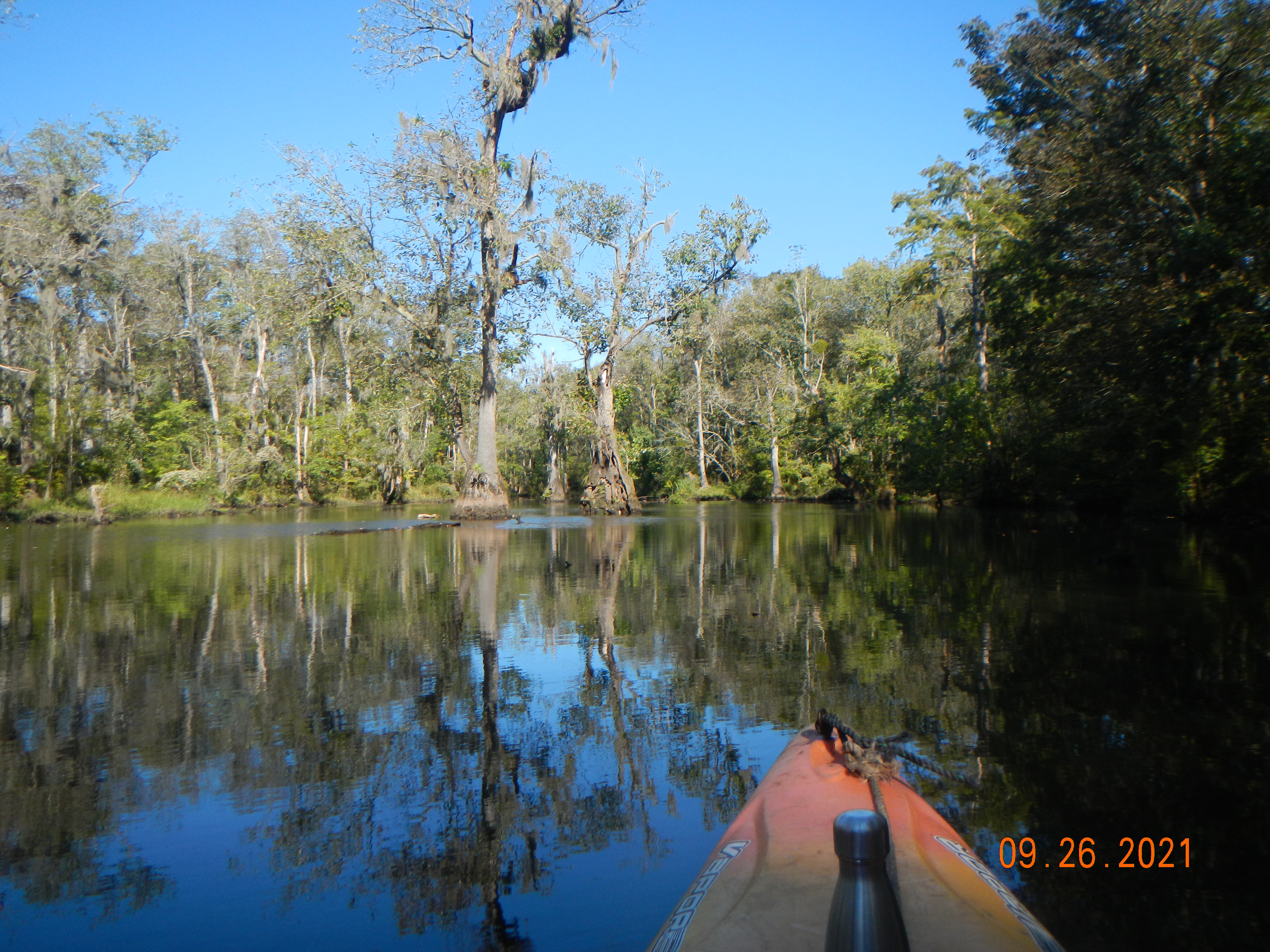Tupelo gum and bald cypress (Nyssa aquatica and Taxodium distichum) are the main trees you are likely to find in perennially flooded deepwater swamps and stream channels in the southeastern U.S.A. Once established, they can grow in sites that are always inundated. However, they cannot germinate from seeds and establish seedlings in standing water. The substrate must be exposed at least once, at the right time of year, for that to happen.
So how come you can find cypress and tupelo growing in perennially flooded areas, in standing water, that apparently never dry out? How do they get a start on the bottom of a stream or lake?

Pinetree Creek, an anabranch of the lower Neuse River, N.C.
The obvious answer is that they (or their parents, if they grew from stump sprouts or nurse logs) got their start when the site was not flooded, or always inundated, or that they got their start on some raised spot within the water that is no longer evident.
Here’s the problem, as I see it. I see these underwater-base trees in situations where there appears to be no evidence, or reason to believe, that they have ever dried out, at least within the time span of even two or three generations of trees. They also sometimes occur far from any banks or higher spots, in deep water where there is no extant evidence of channel change. In many cases these occur in systems where no mid-channel bars occur, and though I look for them, I have not yet seen any examples of cypress or tupelo growing on nurse logs or stumps of other species (though Taxodium and Nyssa stumps do frequently survive as germination sites for other species, and stump sprouting does occur, though only occasionally with cypress). Just because I haven’t seen something does not mean it hasn’t happened, of course, but I feel a lot better when there exist empirical examples of proposed or supposed phenomena.
Lower Neuse River
My observations are based mainly on field observations in the lower Neuse River, North Carolina, and other nearby rivers and swamps, and the lower Waccamaw River, South Carolina. I’ve been in a lot of other low-gradient rivers and swamps, particularly in Texas, Louisiana, and the Carolinas, but not when I had begun thinking about this problem, so I was not on the lookout for evidence pertaining thereto.
Once a tree becomes established at a site, stump sprouting or germination on emergent (above the water line) nurse logs or stumps is possible. Establishment on exposed rootwads of uprooted trees is also possible (though again, I haven’t seen that for the case of tupelo or cypress). But how does the initial drowned-base tree get there?
Backwater of the Waccamaw River, SC.
Let’s walk through some possibilities.
1. Water drawdown or drying allows seedling establishment, followed by reflooding. This could happen during extreme droughts, due to flow diversions, or due to temporary upstream damming (e.g., by beavers or logjams). I am skeptical of the drought/climate explanation in my field sites, as there is no record of any drought severe enough to dry out some of these features, or of any Holocene climate drying that could account for it. The diversion and damming are plausible; the lower Neuse is teeming with beavers at present.
2. Initial establishment in discontinuously flooded sites, followed by increased inflow or water level rise. The flooding could occur due to channel avulsions, beaver dams, or logjams.
Core Creek near Cove City, NC; a Neuse River tributary.
3. Initial establishment on near-bank environments high enough to dry out during dry periods, followed by channel change or migration so that the initially near-bank, shallow water patch becomes a perpetually flooded location. This definitely happens, though it cannot account for some deepwater trees far from any banks.
4. Shallowing due to sediment deposition, so that substrates become exposed at low water. The trees become established, and this is later followed by erosional flushing, leaving the trees in a permanently flooded condition. I have seen germination, particularly of cypress, on fresh sediment deposits in swamps, particularly after Hurricane Florence. However, I have no evidence of subsequent flushing.
Mid-channel complex including a large cypress stump and younger trees.
5. Initial establishment on mid-channel bars or islands that are subsequently eroded or drowned. Such islands and bars are rare in the areas I frequent, except those that already support mature trees.
6. Large woody debris in mid-channel. This could provide nurse logs, or stimulate deposition of bars or islands. I have seen many such features, but none supporting cypress or tupelo recruits.
Nurse stumps, Core Creek.
Bald cypress stump supporting a resprouted cypress (left) and serving as a nurse site for a willow tree (right).
Some of these mechanisms definitely occur, and all of them probably occur at least occasionally, though I would feel much better with a few clear field examples. This problem is no doubt relevant to foresters, botanists, and wetlands ecologists, but to me the main scientific fascination is that the presence of these drowned-base trees indicates that some significant geomorphic or hydrologic change or event has occurred. These deepwater trees could give clues or indicators about these changes or events, or at the very least show us where to start looking for other evidence.
